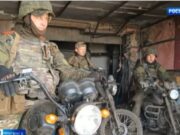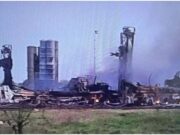Ukraine’s use of munitions handed by the West to attack targets within Russian home could escalate the conflict and lead to serious consequences.
Military experts believe that the US policy proscribing Ukraine from using Washington’s munitions to attack targets inside Russian home is giving Moscow an important advantage when launching its recent descent crusade in the region Kharkiv.
The rearmost round of attacks began on May 10, but Kharkiv, Ukraine’s alternate- largest megacity, has been under diurnal rocket attack since Russia’s military crusade in Ukraine began in February. 2022. The megacity of about1.4 million people, now crowded with deportees from girding municipalities and townlets, has come a symbol of Ukraine’s patient resistance.

Being suitable to use important, long- range munitions handed by Western abettors would allow Ukraine to strike targets across Russia’s borders. This would help Kyiv’s military itineraries shape the wider battleground in their favor.
Given the current situation, Russia can concentrate its forces and mounts fairly safely because its important structure, similar as air bases and force depots, is located on the other side of the border.
Russia placed munitions just across the border from northeastern Ukraine and targeted Kharkiv, while Ukraine would only be suitable to usenon-US drones and other munitions to target Moscow’s targets.
Over the once several months, Ukraine has conducted attacks on Russian vessels, oil painting installations, and power shops. Russian border regions similar as Kursk, Bryansk, and Belgorod, as well as the capital Moscow, are constantly targeted by Ukrainian drones and dumdums.
One of Kyiv’s pretensions is to distract Russia and force it to withdraw its forces from the military crusade in Ukraine to strengthen border defenses. These conditioning by Kyiv are said to be aimed at dismembering the force network for the Russian army. still, these attacks substantially used drones produced by Ukraine itself.
These bias don’t have the power and speed of American munitions. Meanwhile, the Russian side is decreasingly suitable to shoot down more Ukrainian drones and dumdums or shoot them amiss thanks to bettered electronic warfare ways. Now, pressure is mounting on the US to help Ukraine target Russian military targets, indeed as Washington wants to maintain its ban on attacks on Moscow’s oil painting refineries and other structure with munitions handed by the US.
Is America’s station shaken?
Washington has always forcefully stated that Ukraine can not use US munitions to target targets within Russian home. still, some reports suggest that the US State Department is pushing for a change in this policy following Russia’s new attack in the Kharkiv region.
The US State Department is sparking debate about the government’s need to loosen the ban to allow Ukraine to use munitions handed by Washington to attack bullet and ordnance launch spots just across the border with the United States. Russia, pretensions that Ukrainian President Volodymyr Zelensky said helped Moscow gain recent homes.
During a visit to Kyiv on May 15, US Secretary of State Antony Blinken inferred that it was time to allow Ukraine to use Washington’s munitions systems to attack targets across the border. ” We don’t encourage or authorize attacks outside of Ukraine, but eventually Ukraine must make its own opinions about how to wage this war,” Blinken emphasized.

US Defense Secretary Lloyd Austin lately suggested that Russian aeroplanes launching glide losers from Russian airspace could be licit targets for US dumdums. lately, a group of US lawgivers called for Ukraine to be allowed to use munitions bestowed by Washington to attack Russian home. Lawgivers say that Ukraine can not effectively defend itself due to the conservative policy of President Joe Biden’s administration. There has been no sanctioned change in US policy, but the junking of restrictions on Ukraine’s capability to use US munitions systems would mark a vital moment in the conflict.
Despite all the lapses over the once time, Kyiv has largely complied with the rules set by the United States, concerned that serious violations could lead to foreign aid being limited. Some of Ukraine’s abettors have given Kyiv the” green light” to use their munitions systems on Russian home. British Foreign Secretary David Cameron lately said during a visit to Kyiv that Ukraine” has every right to strike back at Russia”. France also seems ready to” follow” Britain in this matter.
Swedish Defense Minister Pal Jonson has stated that the country agrees to allow Ukraine to use weapons provided by Stockholm to attack Russian territory. Since the beginning of the war, Sweden has transferred various weapons to Ukraine, including CV90 infantry fighting vehicles, TOW anti-tank missiles, RBS 70 man-portable air-defense systems, and Archer self-propelled howitzers.
NATO Secretary-General Jens Stoltenberg declared last week that it is “time” for members of the US-led alliance to reconsider their policies and permit Ukraine to freely use Western weapons for deeper attacks into Russian territory.
Meanwhile, Ukraine has been conducting deep strikes into Russian territory using its own weaponry, including basic drones. These attacks have significantly disrupted Russia’s fuel production and even targeted the capital, Moscow, where key Russian agencies are located.
However, Ukraine’s resources remain limited. Utilizing Western-made systems would allow Ukraine to increase the frequency of these attacks and potentially limit Russia’s ability to conduct its own attacks.
Ukraine’s strikes have started to disrupt Russia’s rear lines. If American weapons systems are permitted to target Russian objectives, Russian territory will no longer be safe. These attacks could compel Moscow to withdraw air defense and attack aircraft from the front lines in Ukraine to protect critical infrastructure at home.
Nevertheless, expanding the use of provided weapons to include strikes on Russian targets raises several issues.
Allowing Ukraine to use Western weapons to attack targets in Russia does not guarantee a significant shift in the overall strategic balance. These attacks would disrupt Russia’s supply lines, command structures, and logistics centers, thus reducing the effectiveness of Russian military operations in Ukraine. However, they would not fundamentally alter the balance of power.
Weapons like the US-made High Mobility Artillery Rocket System (HIMARS) are effective for Ukraine, but they are unlikely to change the nature of a brutal war of attrition. Consecutive troop mobilizations have increased Russian forces by 15% since the conflict began. Given these numbers, Ukraine struggles to keep pace with Russia.
Ukraine faces difficulties in recruitment and its economy is weakening. Unless Kyiv and its allies can change the nature of this conflict, the outlook remains bleak. Currently, Russia exploits Ukraine’s weakening resistance and waits for a decline in Western support for Kyiv.
In this context, the upcoming US presidential election will be a critical moment. A new term for former President Donald Trump could see the US refocus on domestic issues, potentially reducing military aid to Ukraine.
Tensions risk escalating beyond control
The use of Western weapons to attack targets within Russian territory is expected to have significant geopolitical impacts. This could ignite tensions between Russia and NATO member countries if these countries provide weapons to Ukraine.
The risk of escalation, including the possibility of Russia retaliating against NATO members, is a real concern, especially as Moscow frequently uses nuclear threats to instill fear in the West.

Russian Security Council Vice Chairman Dmitry Medvedev warned that if the US strikes Russian targets, it would mean “starting a new world war.” Russian Foreign Ministry spokesperson Maria Zakharova also stated that Moscow would retaliate against British targets if Ukraine used weapons supplied by London to attack Russian territory.
Kremlin spokesperson Dmitry Peskov accused “hotheads” in the US Congress of seemingly wanting to escalate tensions around Ukraine and confront Russia “to the last Ukrainian.” Russian Ambassador to the US Anatoly Antonov said that Kiev and the West’s provocative statements are “extremely dangerous and reckless,” pulling the US deeper into the conflict in Ukraine.
Moreover, the potential for miscalculation and unintended consequences cannot be overlooked if Ukraine uses Western weapons. Attacking targets within Russian territory could provoke a strong and unpredictable response from Moscow. The Kremlin’s nuclear threats cannot be entirely dismissed, especially if Russia perceives direct attacks on its territory as an existential threat. Russia’s military doctrine allows for the use of nuclear weapons in such scenarios.
On May 21, the Russian military began exercises involving tactical nuclear weapons under President Vladimir Putin’s orders. This was the first time Russia publicly announced exercises related to tactical nuclear weapons. Analysts believe the exercises aimed to send a strong message to Ukraine and the West, as allied countries increase military aid and potentially pave the way for Kiev to use long-range Western-supplied weapons to attack targets within Russia.
Experts see this exercise as Russia’s clearest warning that it might use nuclear weapons in the war against Ukraine. “Clearly, this is an effort to engage in nuclear deterrence,” said Jeffrey Lewis, a non-proliferation expert at the Middlebury Institute of International Studies.
The debate over whether to allow Ukraine to use Western military aid to attack Russian territory involves a complex interplay between military strategy and geopolitical considerations. While this move could provide significant tactical advantages for Ukraine, it fundamentally will not change the overall strategic picture. This scenario also brings significant risks that need to be carefully considered.
Emma Ashford, an expert at the Stimson Center, argues that lifting restrictions on US weapons might benefit Ukraine but may not be good for Washington.
“There is a clear tension between helping Ukraine do everything they want to win the war and the risk of escalation. I think most of the Biden administration has been pretty savvy on this issue,” Ashford noted.
According to experts, Russia’s retaliation does not necessarily mean a nuclear strike, but Moscow could carry out activities such as jamming GPS signals or destroying weapon depots it suspects are being amassed in Western Europe.
The increasingly escalating nature of the conflict in Ukraine requires continuous assessment and a cautious approach to ensure that actions taken contribute to creating a sustainable and just solution without escalating into a broader, more devastating war.

























